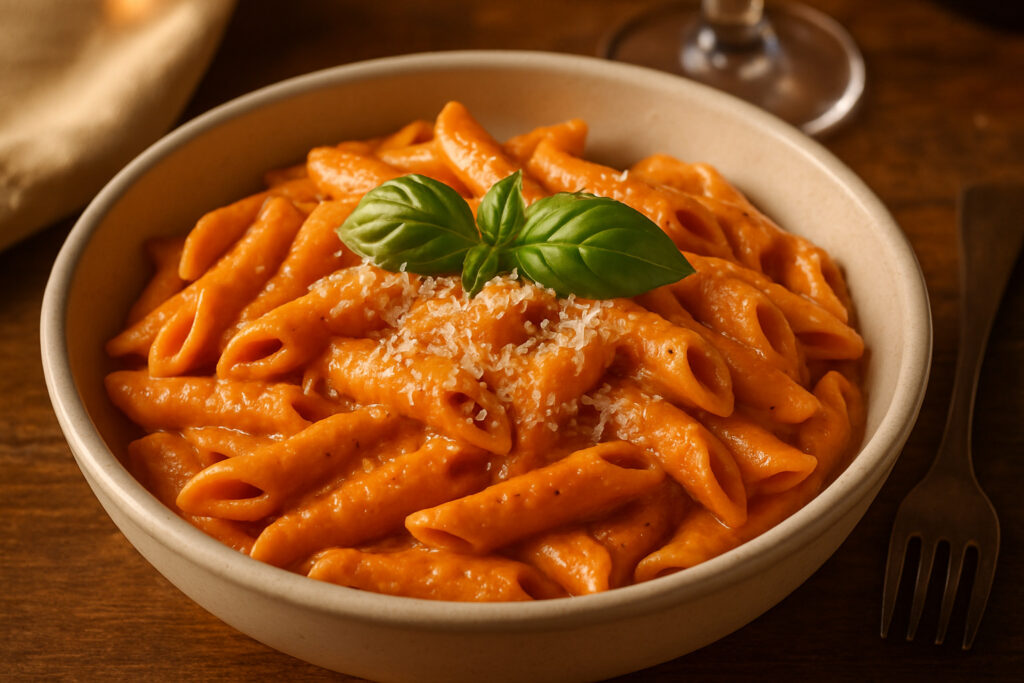The Creamy Magic of Vodka Sauce
Vodka sauce is a rich, creamy tomato-based pasta sauce that combines tomatoes, heavy cream, vodka, herbs, and cheese into a distinctive orange-pink sauce with incredible depth of flavor.
“Friends will think they are in a five-star restaurant and that you slaved for hours. That’ll be our secret.” – Common saying among vodka sauce enthusiasts
What is Vodka Sauce?
| Characteristic | Description |
|---|---|
| Origin | Italian-American cuisine from the 1970s-80s |
| Base ingredients | Tomatoes, heavy cream, vodka, cheese |
| Flavor profile | Creamy, tangy, slightly peppery with balanced acidity |
| Color | Distinctive orange-pink |
| Common pairing | Penne pasta (as “Penne alla Vodka”) |
| Alcohol content | Negligible after cooking (alcohol evaporates) |
Vodka sauce has surged in popularity in recent years, with one viral social media post receiving over 17 million views in 2024. This creamy, luxurious sauce has become so popular that it has “left the pasta” – appearing on everything from pizza to Korean rice cakes (tteokbokki).
But what makes this sauce special isn’t just its striking color or creamy texture. The vodka plays a crucial role in the chemistry of the sauce – it helps emulsify the tomatoes and cream while enhancing the natural flavors of both ingredients. The alcohol evaporates during cooking, leaving behind a sauce with incredible depth and a subtle peppery heat that’s impossible to achieve without it.
Whether you’re making it for a quiet weeknight dinner or looking to impress dinner guests, mastering vodka sauce is a culinary skill worth acquiring. In this guide, we’ll walk through everything you need to know about creating the perfect vodka sauce from scratch, exploring its origins, science, and the techniques that will lift your pasta game forever.
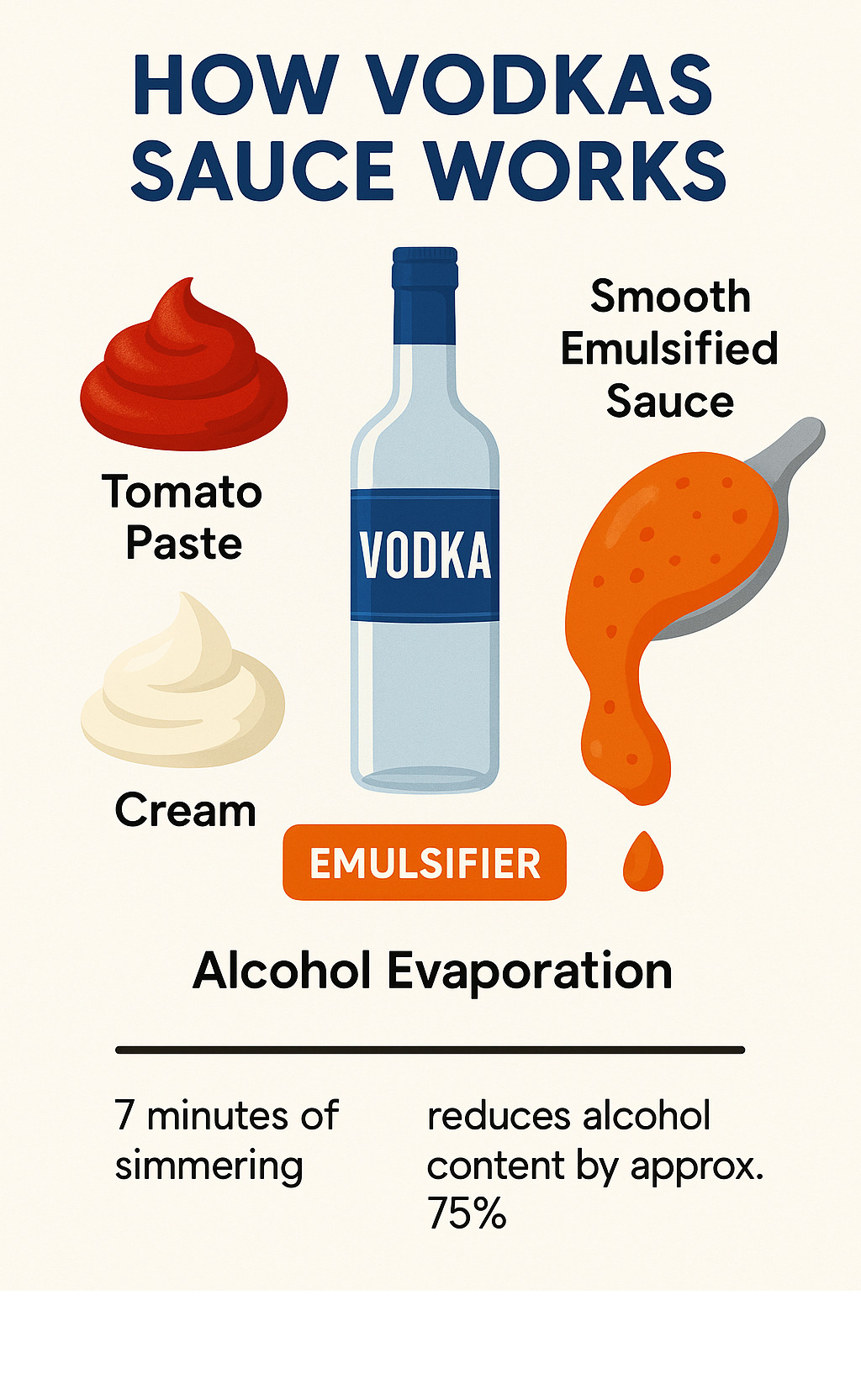
Vodka sauce word guide:
The Science and History Behind Vodka Sauce
Who actually invented vodka sauce? It’s a delicious mystery wrapped in a creamy, tomato-based enigma. Most food historians point to the 1970s-80s as its birthplace within Italian-American culinary circles. Some credit a famous Italian actor for its creation, while other origin stories mention a restaurant in Bologna, an enterprising Columbia University student, or even Russian culinary influence.
At The Dining Destination, we’ve explored countless food traditions, and we’ve found that the most beloved dishes often have the haziest origins. As one culinary historian told us with a chuckle, “Meh, as much as I love delving into the history of famous dishes, I can live with this mystery remaining unsolved.” What’s clear is that by the 1980s, vodka sauce had become a fixture in Italian-American restaurants across the United States.
Fast forward to the 2020s, and this sauce’s distinctive orange-pink hue has made it an Instagram and TikTok sensation. The popularity has grown so much that even Costco jumped on the bandwagon in 2024, introducing their own pre-made spicy vodka sauce to meet skyrocketing consumer demand.
What about those famous San Marzano tomatoes that lift a good vodka sauce to greatness? These prized plum tomatoes from Italy’s Campania region offer the perfect sweet-acid balance that forms the foundation of an exceptional sauce. Their meaty texture and low seed count create that silky-smooth consistency that makes you want to lick the plate clean.
Interestingly, latest research on vodka choice suggests you don’t need to break the bank on premium vodka for this sauce. While quality does matter somewhat (higher-proof vodkas require longer cooking time), the specific brand has minimal impact on your final masterpiece.
What Vodka Does in Vodka Sauce
Despite being essentially flavorless, vodka performs several crucial roles in this beloved sauce:
First, it works as a flavor improver by acting as a solvent that releases compounds in tomatoes that would otherwise remain locked away and undetectable to our taste buds. It also delivers a subtle peppery heat that beautifully balances the richness of the cream.
Perhaps most importantly, vodka serves as an emulsifier, helping the water-based tomato sauce and fat-based cream blend into a stable, cohesive mixture that won’t separate on your plate. Finally, it functions as a balancing agent, cutting through both the sweetness of tomatoes and richness of cream for perfect harmony.
Blind tastings confirm that roughly a quarter cup of vodka per quart of sauce, simmered for about seven minutes, noticeably improves the fruity tomato aroma and creates that balanced heat that makes vodka sauce so distinctively delicious.
Why This Sauce Went Viral
In our work tracking food trends across New York City and beyond at The Dining Destination, we’ve had front-row seats to the vodka sauce phenomenon. But what explains its massive social media success?
That vibrant orange-pink color is Instagram gold – instantly recognizable and utterly photogenic. One viral post featuring vodka sauce racked up an astonishing 17 million views in late 2023 alone.
The sauce also occupies that perfect sweet spot between accessible and aspirational. Most home cooks can make a decent version with pantry staples, but there’s enough technique involved that mastering it feels like a genuine accomplishment worth sharing with friends and followers.
Scientific research on culinary trends suggests foods with strong visual identity and cultural cachet perform exceptionally well on social platforms – and vodka sauce delivers on both counts.
Its remarkable versatility has also contributed to its staying power. As Epicurious noted in 2023, vodka sauce has “left the pasta,” appearing on everything from pizzas to breadstick dipping sauce, and even making surprise appearances in fusion dishes like Korean tteokbokki.
The Ultimate Vodka Sauce Recipe: Step-by-Step Guide
Ready to create the vodka sauce of your dreams? Let’s roll up our sleeves and get cooking. This recipe makes enough sauce to generously coat 1 pound of pasta, serving 4-6 hungry diners with something truly special.
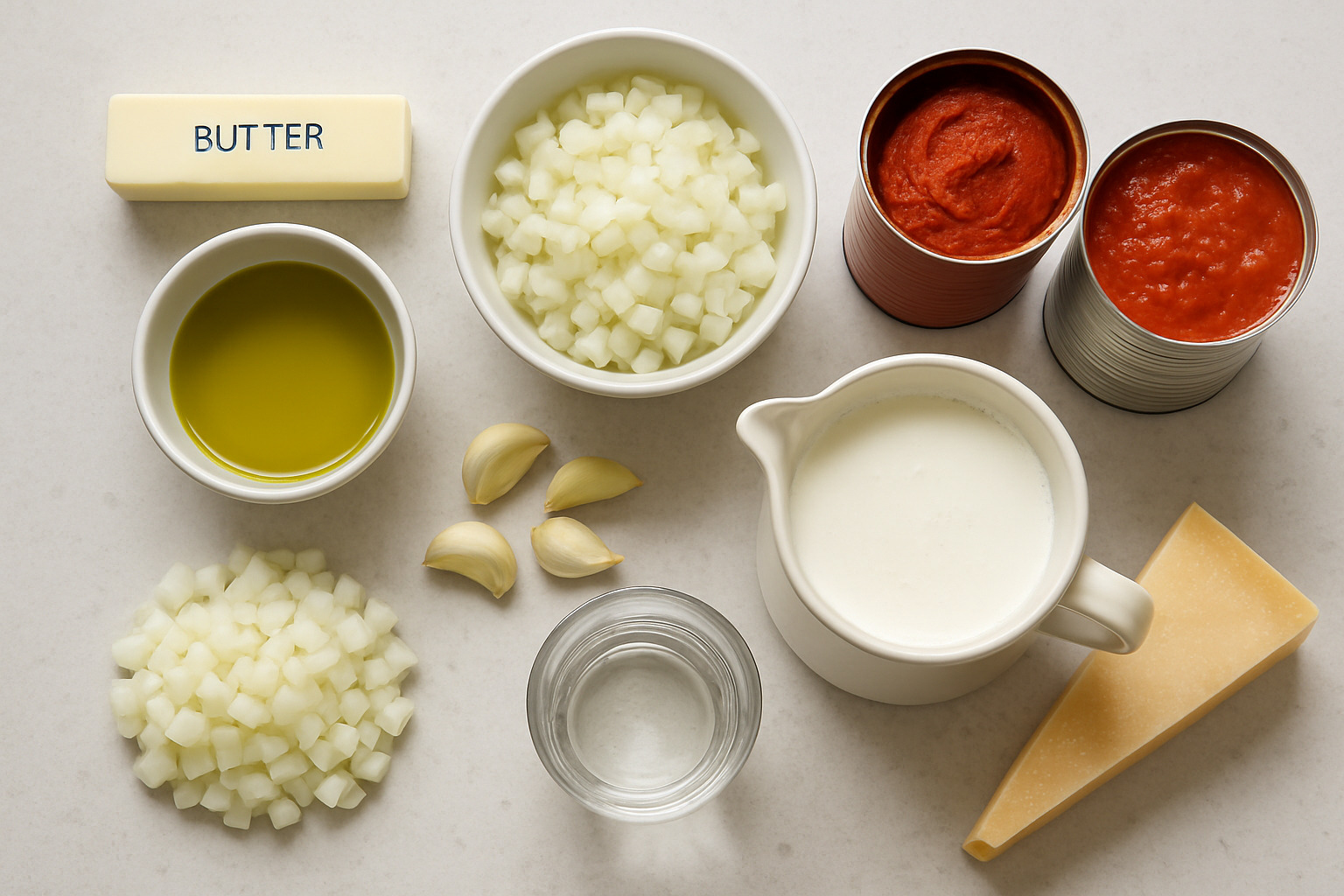
Key Ingredients for Classic Vodka Sauce
I’ve made vodka sauce dozens of times at home and during our culinary tours at The Dining Destination, and I’ve found that quality ingredients make all the difference.
The tomato component is where the magic begins. Combining tomato paste with whole peeled tomatoes creates this beautiful balance of concentrated richness and fresh acidity. San Marzano tomatoes are worth seeking out here—their natural sweetness and low seed count create a silky-smooth foundation.
For the vodka, you don’t need to break the bank. A mid-range, unflavored vodka works perfectly—about ¼ cup per quart of sauce is the sweet spot we’ve found through much delicious testing.
The heavy cream should be just that—heavy. Light cream or half-and-half simply won’t create that luxurious texture that makes vodka sauce so irresistible. And please, grate your Parmigiano-Reggiano fresh—the pre-grated stuff just doesn’t melt properly.
Red pepper flakes provide that subtle heat that balances the richness, while fresh basil brightens everything up at the end. The combination is simply magical.
Vodka Sauce Cooking Timeline
Making vodka sauce isn’t complicated, but there is a rhythm to it. Here’s how the cooking process unfolds:
Start by melting butter with a splash of olive oil in a large skillet over medium heat. Add your finely diced onion and cook gently for about 8 minutes. Patience is key here—you want the onions soft and translucent, not browned. This 10-minute aromatics phase builds your flavor foundation.
Once your onions are soft, add thinly sliced garlic and red pepper flakes, cooking for another 2 minutes until the kitchen smells like heaven.
Now comes a crucial step that many recipes skip: add your tomato paste and cook it for a full 3 minutes, stirring frequently. The paste will darken slightly and become fragrant. This brief caramelization transforms the tomato flavor from flat to fantastic.
Time to deglaze with vodka! Pour it in and stir, scraping up any browned bits from the bottom of the pan. Let it bubble away for about 2 minutes—this cooks off the harshest alcohol while preserving the vodka’s flavor-enhancing properties.
Add your hand-crushed whole tomatoes with their juice and simmer for about 15 minutes. This is a good time to drop your pasta into boiling water, cooking it just shy of al dente. Don’t forget to reserve some pasta water before draining!
For that signature silky texture, blend your sauce right in the pan with an immersion blender. If you don’t have one, carefully transfer to a standard blender, leaving a vent for steam.
The final touch: reduce the heat to low and stir in the heavy cream. Add your freshly grated Parmigiano-Reggiano and stir until melted. Toss in your pasta with a splash of that reserved pasta water—the starch helps the sauce cling beautifully to every bite. Finish with torn basil leaves and maybe a little more cheese (because why not?).
From start to finish, you’re looking at about 40 minutes of active cooking time. The sauce comes together in under an hour, but the flavors continue to develop if you have the patience to let it sit for a few minutes before serving.
What I love most about making vodka sauce is how it transforms humble ingredients into something that feels truly special. Whether it’s a quiet weeknight dinner or you’re hosting friends, this sauce never fails to impress. And as we often say at The Dining Destination, the best souvenirs from your culinary trips are the recipes you bring home and make your own.
Pro Tips, Variations, and Dietary Tweaks
Whether you’re a vodka sauce purist or looking to put your own spin on this classic, I’ve got you covered with professional tips and creative variations that I’ve perfected through years of testing in my own kitchen.
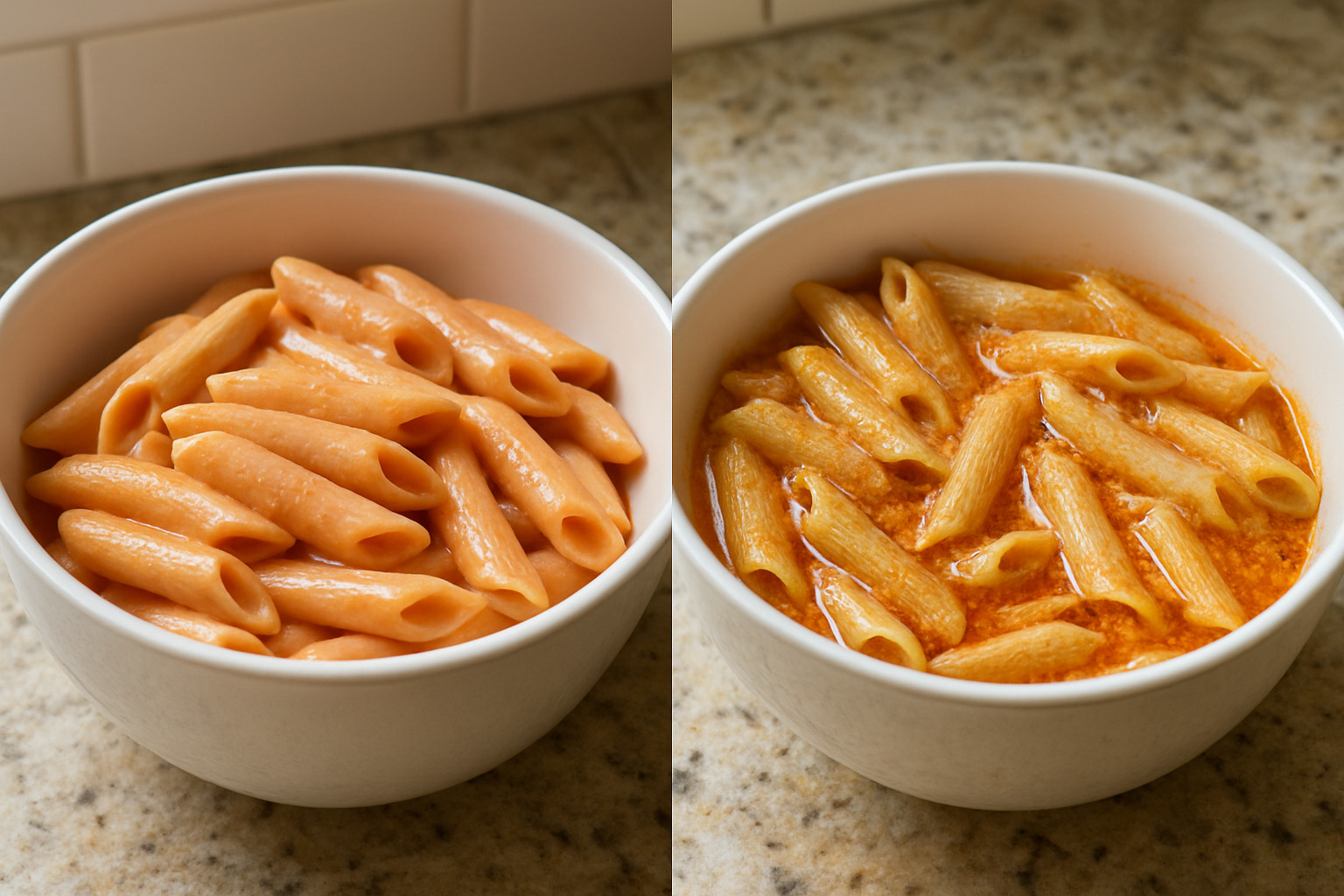
Avoid These Vodka Sauce Pitfalls
Nothing’s more disappointing than watching your beautiful vodka sauce break apart just as you’re ready to serve. The most common mistake I see home cooks make is scorching those delicate aromatics. When onions and garlic burn, they release bitter compounds that will haunt your sauce no matter what you add later. Keep that heat medium-low and be patient!
When it comes to the vodka itself, timing matters. You want to cook off most of the alcohol, but completely evaporating it before adding your tomatoes means missing out on that magical reaction between alcohol and tomato compounds that makes vodka sauce so special.
The dreaded curdled cream is another heartbreaker. I learned this the hard way at a dinner party years ago! To keep your sauce silky smooth, always lower the heat before adding cream, let the sauce cool slightly if it’s been bubbling away, and try to bring your cream to room temperature first. Adding it gradually while stirring constantly also helps tremendously.
Those pre-grated cheeses in plastic tubs? They’re convenient but contain anti-caking agents that will leave your sauce grainy rather than velvety. Take the extra minute to grate fresh Parmigiano-Reggiano – your taste buds will thank you.
If your vodka sauce seems too thin, resist the urge to continue reducing it after adding cream. This almost always leads to breaking. Instead, use a bit more tomato paste in your initial cooking or employ my favorite restaurant trick: add your pasta directly to the sauce with a splash of that starchy pasta water and let it finish cooking right in the sauce.
Making Vodka Sauce Kid-Friendly & Alcohol-Free
“Can my kids eat this?” is a question we hear often at The Dining Destination. The good news is that properly cooked vodka sauce contains negligible alcohol. Simmering for at least 7 minutes reduces the alcohol content by approximately 75%, and longer cooking reduces it further.
For those who prefer to avoid alcohol entirely, you can create a delicious “mock” vodka sauce that’s nearly indistinguishable from the original. Try substituting the vodka with chicken or vegetable broth plus a teaspoon of fresh lemon juice. The acid from the lemon helps mimic vodka’s flavor-enhancing properties. Another great option is using water with a couple teaspoons of lemon juice, or white grape juice with a splash of white wine vinegar if you want a touch of sweetness.
To compensate for vodka’s absence, I like to add a pinch of extra red pepper flakes, a small spoonful of additional tomato paste, or a generous handful of fresh herbs. While these substitutions won’t perfectly replicate the chemistry of vodka in the sauce, they’ll still produce a creamy tomato sauce that most people wouldn’t identify as missing anything.
For dietary variations, consider these tweaks I’ve perfected over years of testing: crisp pancetta adds wonderful depth (cook it first, then use the rendered fat to sauté your onions); Calabrian chili paste creates a spicier version that wakes up the palate; and for my vegan friends, cashew cream and nutritional yeast make a surprisingly convincing dairy-free alternative.
Those watching fat intake might opt for half-and-half instead of heavy cream, though be warned that the sauce will be less stable and more prone to breaking. As for herbs, while basil is traditional, fresh oregano, thyme, or a bit of rosemary can take your vodka sauce in delightful new directions.
Want to explore more creative sauce variations? Check out The secret behind our signature sauces & seasonings for more inspiration from our test kitchen.
Perfect Pairings: Pasta Shapes, Proteins, Sides & More
The right pasta shape can truly lift your vodka sauce experience. While penne has become the traditional choice (hence the classic “penne alla vodka”), several other shapes work beautifully with this creamy, luxurious sauce.

Pasta Pairings for Vodka Sauce
When we host pasta nights at The Dining Destination events, we often get asked about the best pasta shapes for vodka sauce. The truth is, short, tubular pasta shapes with ridges or grooves are ideal because they trap the creamy sauce both inside and on their textured surfaces.
Penne rigate, with its diagonal cut ends and ridged exterior, has become the classic choice for good reason – each piece captures the perfect amount of sauce both inside the tube and along the ridges. If you’re serving a heartier portion, rigatoni’s wider tubes hold even more of that luscious sauce in each bite.
For a more playful presentation, cavatappi (corkscrew pasta) traps the sauce in its spiraled curves, making each bite a delightful experience. Fusilli works similarly, with its tight spirals catching creamy sauce in every twist. And don’t overlook campanelle – its flower-like ruffles hold sauce beautifully, making for an neat plating option.
For a truly comforting twist, pillowy gnocchi pairs wonderfully with vodka sauce, creating a textural contrast that’s absolutely divine. The soft potato dumplings absorb just enough sauce while maintaining their distinct texture.
While long pasta shapes like spaghetti can work, they simply don’t capture the sauce as effectively. If you’re set on long pasta, consider fusilli col buco—a spiral, hollow noodle that offers the best of both worlds.
For a slightly more nutritious option without sacrificing flavor, whole-wheat pasta adds a pleasant nutty flavor that actually complements the richness of vodka sauce quite nicely.
Beyond Pasta: Creative Uses for Vodka Sauce
Vodka sauce has broken free from its pasta-only reputation, and creative chefs (including our team at The Dining Destination) have finded countless delicious applications.
Next time you’re making homemade pizza, try spreading vodka sauce on your dough instead of traditional tomato sauce. Top it with fresh mozzarella and basil for a creamy twist on a Margherita that will have your friends begging for the recipe.
As a protein partner, this versatile sauce transforms ordinary proteins into restaurant-quality meals. Spoon it over seared chicken cutlets or use it to finish pan-seared salmon. It’s particularly magical with seafood – grilled shrimp or scallops take on a new dimension when paired with the creamy, tomato-rich sauce.
We’ve seen vodka sauce shine as a sophisticated warm dip for everything from garlic breadsticks to fried mozzarella sticks and even roasted vegetables. The slight tang and creaminess make it far more interesting than standard marinara.
Some of the most exciting applications come from global fusion experiments. Korean rice cakes (tteokbokki) simmered in vodka sauce create a cross-cultural comfort food that’s utterly addictive. Crispy polenta squares topped with vodka sauce and a sprinkle of fresh herbs make for perfect appetizers. And baked gnocchi with vodka sauce and melted fontina? Pure comfort food heaven.
Don’t overlook vodka sauce as a sandwich improver either. At room temperature, it makes a fantastic spread for Italian cold cut sandwiches, and it lifts a simple meatball sub to gourmet status. For the ultimate grilled cheese, spread a thin layer between slices of mozzarella before grilling.
When serving vodka sauce pasta as your main course, balance is key. The sauce’s richness pairs beautifully with bright, slightly bitter vegetables like roasted broccoli or sautéed spinach with garlic. A simple arugula salad with lemon vinaigrette provides the perfect acidic counterpoint. And don’t forget some good crusty bread or focaccia for sopping up any extra sauce – it’s too delicious to waste!
During our New York City food tours, we’ve noticed an interesting trend: many restaurants now offer vodka sauce as an optional upgrade for various pasta dishes. This versatility and widespread appeal is a testament to why this sauce has captured the hearts (and appetites) of food lovers everywhere.
Frequently Asked Questions about Vodka Sauce
After hosting countless food tours and cooking demonstrations across New York City, we’ve collected quite a list of questions about vodka sauce. Here are the answers to what people ask us most often:
Does Vodka Sauce Contain Alcohol After Cooking?
This question comes up constantly, especially from parents, pregnant women, and those who avoid alcohol for personal or religious reasons.
The reassuring answer is that very little alcohol remains after cooking. When you simmer the sauce, the alcohol gradually evaporates – though not all at once. Research shows that after simmering for 15 minutes, about 60% of the alcohol cooks off. After 30 minutes, that increases to about 65%, and after a full hour, roughly 75% has evaporated.
Consider that a typical vodka sauce recipe only uses about 1/4 cup of vodka per quart of sauce, and you’ll typically simmer it for at least 20-30 minutes. By the time you’re serving, each portion contains such a tiny amount of alcohol that it’s generally considered safe for everyone, including children.
That said, if you’re completely avoiding alcohol for any reason, try one of our alcohol-free substitutions mentioned earlier. No judgment here – the sauce will still be delicious!
What’s the Best Pasta Shape for Vodka Sauce?
While we covered pasta pairings earlier, this question deserves a straightforward answer. Traditionally, ridged tubular shapes like penne rigate and rigatoni work best with vodka sauce for three simple reasons:
First, those little tubes capture delightful pockets of the creamy sauce. Second, the ridges on the outside hold even more sauce. And third, these shapes have the sturdy structure needed to stand up to such a rich coating.
But honestly? The “best” pasta shape is whatever makes you happy. We’ve seen amazing vodka sauce dishes made with everything from gnocchi to fusilli col buco. Some of our tour guests even swear by using shells to capture little pools of the sauce. Follow your heart (and your hunger)!
Can Vodka Sauce Be Frozen Successfully?
Yes! But here’s the important trick: freeze it before adding the cream.
For best results, prepare your vodka sauce up to the point just before adding cream and cheese. Let it cool completely, then portion it into freezer-safe containers or bags. Label them (trust us, in three months you won’t remember what that orange stuff is), and freeze for up to 3 months.
When you’re ready to use it, thaw in the refrigerator overnight. Then gently reheat on the stove before adding fresh cream and cheese. This method gives you that fresh-made taste even with freezer convenience.
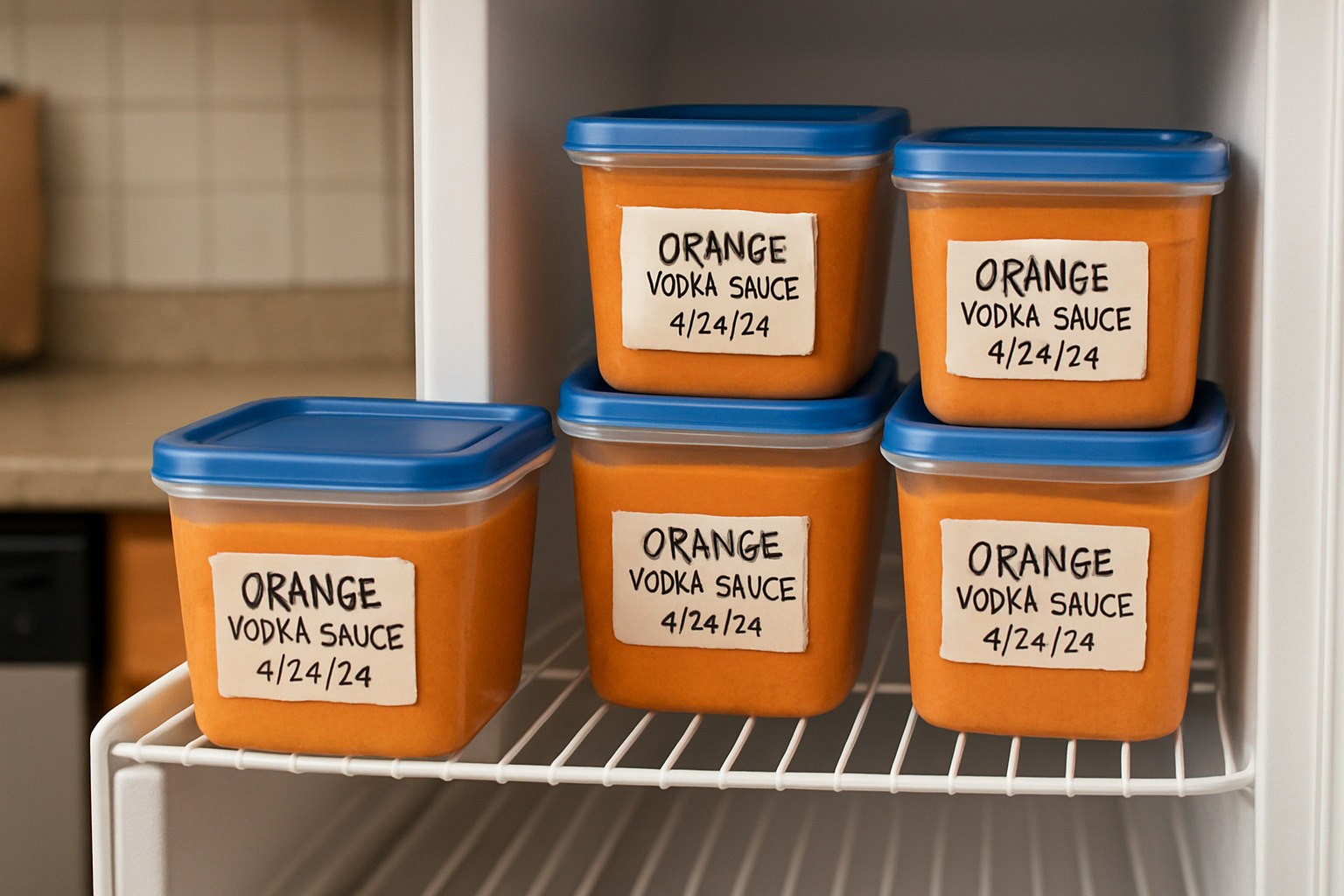
Already added cream and need to freeze leftovers? It’s still possible, though the sauce might separate slightly when thawed. To bring it back to life, thaw completely, then reheat very gently over low heat while whisking continuously. A splash of fresh cream can help re-emulsify everything if needed.
I’ve personally rescued many a separated sauce this way during our cooking demonstrations, much to the relief of our participants who made too much and didn’t want to waste it!
Conclusion
Mastering vodka sauce is one of those culinary skills that gives you incredible returns on a relatively modest investment of time and effort. There’s something almost magical about changing a few simple ingredients into a sauce that’s simultaneously rich and bright, creamy and complex.
Throughout this guide, we’ve uncovered the fascinating history behind this beloved sauce, explored the chemistry that makes it work, and shared techniques to help you create the perfect version at home. Whether you stick with our classic recipe or venture into creative territory with one of our suggested variations, your dinner guests will be impressed.
I’ve found that understanding the “why” behind cooking techniques makes us all more confident and creative in the kitchen. The science of vodka sauce—from the way alcohol acts as an emulsifier to how it improves tomato flavors—is a perfect example of culinary chemistry at work in an everyday dish.
Next time you’re hosting friends for dinner, consider serving this impressive yet approachable pasta. That vibrant orange-pink sauce coating perfectly al dente pasta creates a moment of anticipation that’s hard to beat. As the saying goes, your friends will think they’re dining at a five-star restaurant, and that you spent hours in the kitchen—but that can be our little secret.
Cooking is as much about sustainability as it is about flavor. Freezing extra vodka sauce or repurposing it in creative ways (like that vodka sauce pizza we mentioned) helps minimize waste while maximizing enjoyment. For more insights into sustainable cooking practices, check out our guide on sustainable dining – more than a trend.
The next time you’re stirring a pot of bubbling vodka sauce, watching the cream swirl into that vibrant tomato base, take a moment to appreciate the simple joy of creating something truly delicious. That’s what cooking is all about.
Happy cooking from all of us at The Dining Destination!

